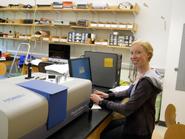
Solar cells hold the potential to provide an efficient and environmentally-clean energy source. With the recent interest in alternative forms of energy, solar power is gaining importance, and so is research on solar cell efficiency. Over the summer, Sarah Fobes is working on an innovative method of improving solar cell efficiency using rare earth elements. She is collaborating with Professor of Physics Ann Silversmith on their project, “Quantum Cutting to Enhance Solar Cell Efficiency.”
There are certain elements that can absorb a high-energy photon, or unit of light, and emit two low-energy photons. This process is known as quantum cutting. One element capable of quantum cutting is the rare earth metal ytterbium, which can absorb a high-energy photon emitted by terbium and then emit lower-energy photons.
White light emitted by the sun is characterized by photons of a very wide range of wavelengths, yet modern solar cells can only capture and utilize a small portion of this light. Fobes’s research focuses on the potential of using quantum cutting in solar cells to broaden their capabilities and maximize their efficiency.
Fobes starts her experiments by making nanocrystals containing both terbium and ytterbium. These nanocrystals look like a fine powder, and when exposed to UV light, they convert the higher-energy photons into low-energy photons. She runs this powder through a sensitive instrument that can aim a very precise wavelength of light at her sample to see how the nanocrystals interact with the light.
The study of the interactions between matter and light is referred to as spectroscopy. Fobes had worked with spectroscopy the previous summer and finds the topic to be highly interesting. Her current project joins chemistry and physics, and she plans to continue it as her senior thesis. The project was conceptualized by Silversmith, but Fobes has a lot of freedom with her experiments, and she enjoys having an active role in the study’s design and implementation.
Ultimately, Fobes hopes to gain a thorough mathematical understanding of how to maximize the gains in efficiency from quantum cutting. She is optimistic about the possibility of utilizing quantum cutting in solar cells, stating, “Early results indicate that it can be done, and it can be done quite well.” She looks forward to demonstrating that quantum cutting can be a very viable option for increasing the efficiency of modern solar cells.
Apart from her interest in physics, Fobes enjoys ballroom and Latin dance, which she peruses as president of Tropical Sol, Hamilton’s performance Latin dance group, and as president of the ballroom dance club.
As people become more environmentally conscious, there is an increasing demand and need for alternative forms of energy. Solar energy can provide one such option, and the efforts of researchers such as Fobes make solar cells more effective and attractive.
Sarah Fobes is a graduate of Hopkins High School in Minnetonka, Minnesota
